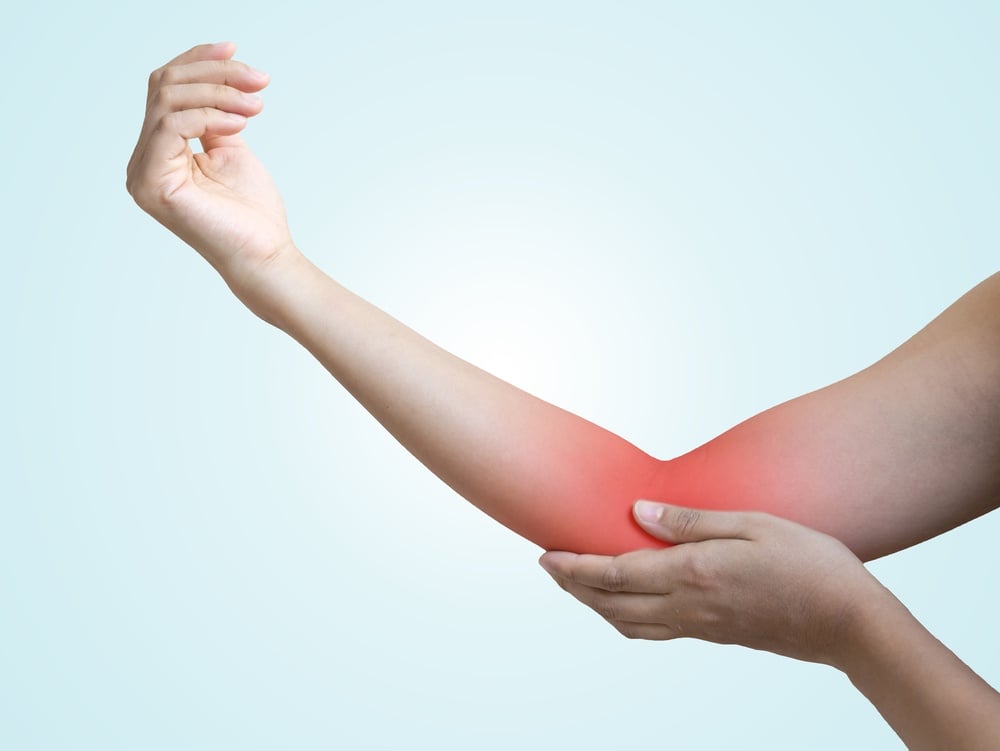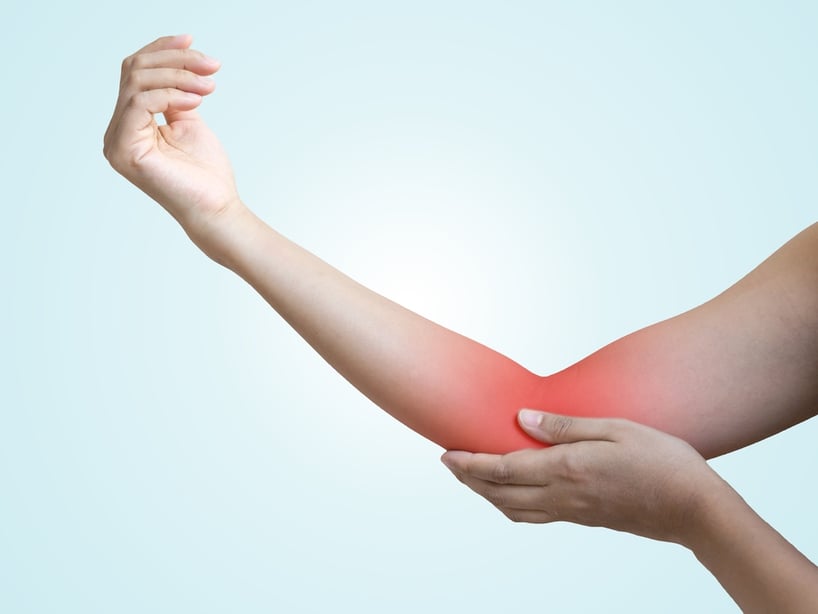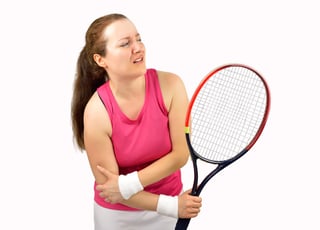Elbow Injuries: Types, Therapy Options, Common Surgeries
February 20th, 2017 | 6 min. read


The elbow joint is a synovial (fluid-filled) hinge joint with several important functions: moving your hand toward and away from your body, rotating your forearm, and flexing and extending the arm (bending and straightening the elbow). To make all this movement happen, your joint consists of bones, cartilage, ligaments, and fluid. Any one of these can be harmed from overuse, leading to injury.
Elbow Injuries: How They Happen
Most elbow injuries that bring people to the doctor are caused by repetitive strain, either from athletic injuries or other forms of overuse.
Repetitive strain injuries occur when you repeat an activity over and over again, with little time off between sessions to allow the body to heal. Over time, the joints or muscles involved in the activity can become inflamed or aggravated due to overuse. Symptoms like pain, swelling, stiffness, or weakness may begin gradually and worsen over time.
Among athletes, overhand throwers who use significant force and speed are the ones most likely to complain of elbow injury (think baseball pitchers or football players).
However, many different activities and sports can cause repetitive strain damage:
- Overuse from sports. Performing repetitive motions can lead to strain and inflammation in the tendons and ligaments in the inside and outside of the elbow joint — especially if the motions are weight-bearing or involve exerting a force to counteract another force (like you do when swinging a club, hitting or throwing a ball, or pushing against water when swimming laps).
Throwing sports like football and baseball are particularly infamous for causing injuries along the inner side of the elbow.
However, you may also injure your elbow playing the following:
- Baseball/softball
- Bowling
- Football
- Golf
- Martial arts
- Swimming
- Tennis or racquetball
- Yoga
- Weight lifting/resistance training (when repeatedly bending and straightening the arm at the elbow, for example when performing biceps curls, dips, push-ups, or pull-ups)
- Overuse at work. Elbow strain can also occur as the result of repeated motions at work: anything that involves bending and straightening the elbow or moving the forearm can cause trouble. For example:
- Industrial work, like automobile repair, home renovations and building, or plumbing
- Office work like mousing (using a computer mouse) or typing
- Painting (house painting or making art)
- Restaurant work (cooking and prep, knife work, butchery)
- Overuse from hobbies and other activities. Though less common, you can also strain your elbow performing repetitive arm motions like:
- Cleaning house (scrubbing, vacuuming)
- Knitting or crocheting
- Playing a musical instrument (guitar, bass, cello)
- Yard work (digging, raking, shoveling snow)
- Woodworking or carpentry
If you work in an office or are a "weekend warrior" (someone who is mostly sedentary during the week, but who exercises on weekends), you’re more apt to suffer a sports injury or repetitive strain injury. Muscles, ligaments, and tendons that aren’t accustomed to daily movement can be tight and are more prone to tears and other damage.
Types of Elbow Injuries
Elbow injuries usually affect either the inner or outer elbow, and fall into three categories: soft tissue injuries (tendons, muscles, ligaments), bone injuries (fractures or osteoarthritis), or nerve injuries.
The most common elbow injuries seen by orthopedists and surgeons include the following:
- Tennis elbow (medical term: lateral epicondylitis). An overuse injury affecting the tendons in the outside of the elbow
 joint, this injury is a type of tendinitis (sometimes spelled "tendonitis") that affects the muscles and tendons that control the use of the forearm — specifically, the extension of the wrist and fingers.
joint, this injury is a type of tendinitis (sometimes spelled "tendonitis") that affects the muscles and tendons that control the use of the forearm — specifically, the extension of the wrist and fingers.
Tennis elbow usually announces itself with a weaker-than-normal grip strength and a painful soreness or burning in the outside of the elbow.
You need not play tennis to develop tennis elbow. Many people are surprised to hear that they can sustain the same injury from a variety of different activities that strain the tendons in a similar fashion (for example, doing yard work, swimming, or even typing). - Flexor Tendinitis. If you feel pain on the inside of your elbow when throwing, you may have inflamed
flexor/pronator tendons. These tendons attach to the upper arm bone on the inner side of the elbow. - Ulnar Collateral Ligament (UCL) Injury. This is another inner elbow injury that commonly affects throwers. UCL damage can range from a minor tear and inflammation to a complete ligament rupture. In addition to inner elbow pain, you may notice a decrease in throwing speed.
- Valgus Extension Overload (VEO). Also common in throwers, this injury occurs when the bony prominence on the elbow is forced against the humerus (the upper arm bone). This happens when the arm twists (for example, when overhand pitching a baseball). Continued rubbing can wear away the cartilage on the point of the elbow and stimulate the bone to grow spurs. Bone spurs at the elbow can lead to swelling, pain, and a reduced range of motion.
- Olecranon Stress Fracture. When your muscles become weakened or fatigued they transfer stress to the bone, leading to small cracks. Most people think of stress fractures in the legs (for example, in jumpers or runners). But athletes who throw with great force — notably, baseball pitchers — often experience these painful fractures in the underside of the elbow.
- Ulnar Neuritis. The ulnar nerve passes around the end of the upper arm bone. When it is overstretched or slides out of place, it may snap or become irritated. Ulnar neuritis is common in throwers and presents with an electric shock feeling in the elbow and forearm or numbness, tingling, or pain in the fingers. Non-throwers may also experience this injury if they hold a single body position for too long.
Elbow pain may also be caused by:
- Ligament sprains
- Muscle strains
- Dislocation of the elbow
- Osteoarthritis of the elbow joint
- Bursitis (inflammation of the fluid-filled sacs of the joint)
Self-care Therapy Options
If you experience some elbow soreness but you can move your elbow, you can try to treat your symptoms at home. Some combination of the following may bring you relief.
- RICE therapy. If your pain is sudden or if it flares up, rest, ice, compression, and elevation above the level of the heart can help to limit swelling and pain.
- Taking non-steroidal anti-inflammatory drugs like naproxen and ibuprofen can help to control inflammation and pain symptoms.
- Immobilizing or supporting the elbow. Depending on the injury, you may benefit from taping, wrapping, splinting, or bracing your elbow. An orthopedist or physical therapist can show you how to best support your joint.
- Adjusting your equipment. If you hurt your elbow at work, you may see improvement if you swap out your tools, upgrade to a special ergonomically-designed computer mouse, or change your posture when sitting or standing. If you injured your elbow playing sports, check your equipment to make sure it's properly fit and in good condition so your forearms don't need to overcompensate (for example, for a loosely strung racket).
Common Non-surgical Orthopedic Treatments
If your elbow pain doesn’t respond to at-home treatments, you may need to see an orthopedist for a treatment program that’s somewhere between self-care and surgery. For example, your injury may respond to the following:
- Cortisone shot. To help decrease inflammation in the elbow, a doctor can inject a steroid like cortisone directly into your damaged muscle.
- Extracorporeal shock wave therapy. To increase blood flow to your injury, some orthopedists may attach a probe to your skin that can direct high-energy acoustic waves to your elbow. These waves apply pressure to your muscles and tendons, which may speed healing. (This treatment is considered experimental by some doctor and insurers.)
- Physical therapy/rehab/sports medicine. Exercises designed to strengthen and stretch your forearms may help reduce your pain and improve range of motion. Your PT or sports medicine professional may also use techniques like icing, ultrasound, massage, or muscle-stimulating techniques.
- Platelet-Rich-Plasma (PRP). The platelets in blood contain proteins called growth factors that work to help heal the body. An orthopedist can prepare, from your own drawn blood, a preparation of plasma that contains a concentrated dose of platelets. This plasma can be injected into your elbow to help speed your recovery. This is a relatively new treatment — well-known to professional athletes — that has proven to work well with chronic elbow injuries. Ask your orthopedist's office if PRP is included in their available procedures.
Common Surgical Treatments
If your pain is severe, if you’re feeling numbness in the arm or hands, or if your sports performance and range of motion are suffering, you may want to consider elbow surgery. Making an appointment to see an orthopedist is the first step in determining whether a surgical option may benefit you.
Many orthopedists — including Coastal Orthopedics — specialize in elbow surgery.
Common elbow procedures include:
- Open elbow surgery. The most commonly performed tennis elbow repair surgery, open elbow surgery can usually be done on an outpatient basis at a surgical center. Your surgeon will make an incision over the elbow, then remove diseased muscle and reattach healthy muscle to bone.
- Arthroscopic elbow surgery. This minimally invasive, same-day outpatient procedure is preferred by some patients. An orthopedist will make small incisions and insert a camera scope and miniature instruments into the elbow. The goal of arthroscopy is to remove diseased muscle and reattach healthy muscle to the bone.
- UCL reconstruction (“Tommy John surgery”). In the case of an unstable or torn UCL, oftentimes the ligament needs to be surgically reconstructed with a tissue graft from the patient’s own tendons, rather than simply stitched back together. This procedure is commonplace today, especially among college and professional athletes.
- Ulnar nerve anterior transposition. To relieve ulnar neuritis, a surgeon can actually move the ulnar nerve to the front of the elbow. This may prevent stretching or snapping, eliminating symptoms.
Feel free to call Coastal Orthopedics in Coorpus Christi, Texas with any questions at (361) 994-1166. Or just click the button below to request an appointment.
Article written by: Rob Williams, MD
Dr. Williams has been practicing orthopedic surgery in Corpus Christi since 1998. After graduating from Texas Tech hereceived his medical degree from the University of Texas at San Antonio. At the prestigious Campbell Clinic located at the University of Tennessee, Dr. Williams completed not only an Orthopedic Surgery Residency, but an additional year of Fellowship Training in Spine Surgery. Dr. Williams is dedicated to creating an excellent patient experience in the office or in the surgery suite.
Topics:


